Silom Road in Bangkok has been a sort of mecca for me and my camera over the last 20 years. Though it is only a tiny slice of the city – the street itself is only about 15 blocks long – the ever-widening variety of street life there has kept me coming back again and again.
This is the first of a 3-part series about my street photography in Bangkok, featuring three different locations. This episode reveals how Silom Road has held my attention as a photographer over such a long period of time. The next episode will tell about another quite different street, Charoen Krung Road. The third and final episode will feature another neighborhood, an out-of-the-way part of Chinatown, and night life on the streets there.
Virtually all the photographs from Silom Road stem from street life on the sidewalks. Nearly every day when I was in Bangkok I would walk up and down the entire length of Silom Road over the course of an hour or two in late afternoon, camera at the ready, a sort of ritual. It reminded me of a childhood dream where I was watching a circus from behind a glass wall, but this time I was on the real-life side of the glass.
Every day literally thousands of people walk the sidewalks of Silom Road. Nonetheless, I could see some of them as individuals, which if I’m lucky would result in street portraits. Even more incredible to me, sometimes – rarely – I could find these same subjects time and again over several years, and the result is an extended portrait.
This is a man I came to call Pappi (his real name was Mr. Somprang). I met him repeatedly over a period of 11 years. He seemed to remember me from year to year and greeted me warmly. The series began in 2004. At that time, I was shooting a series about Silom Road in color. I’ve taken the prerogative to convert this image to black-and-white to be consistent with the rest of the portrait.
I didn’t see him again until 2012, though I had traveled to Bangkok often in the interim. That year he was on the sidewalk of Silom Road near the hotel where I always stayed. From 2012 to 2015, I met him at least once or twice a year. He would just sit quietly, sometimes in a wheelchair. Sometimes he sold lottery tickets. I considered Pappi to be my talisman. If I saw him first thing in the morning, it would be a good day.
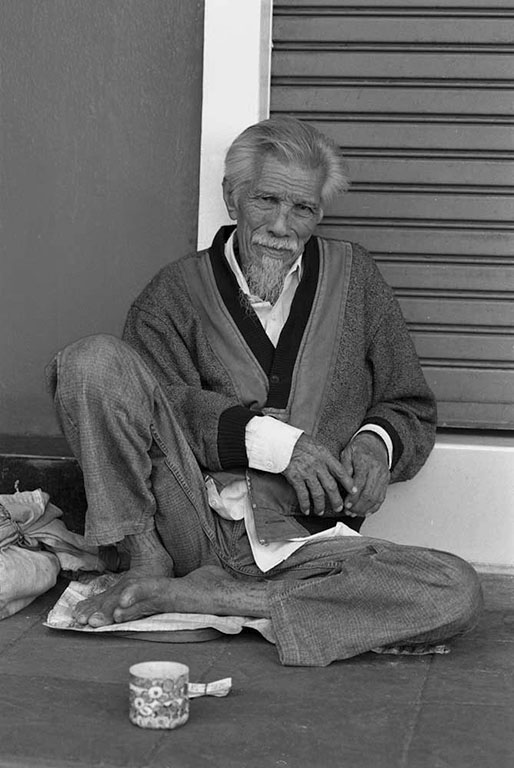
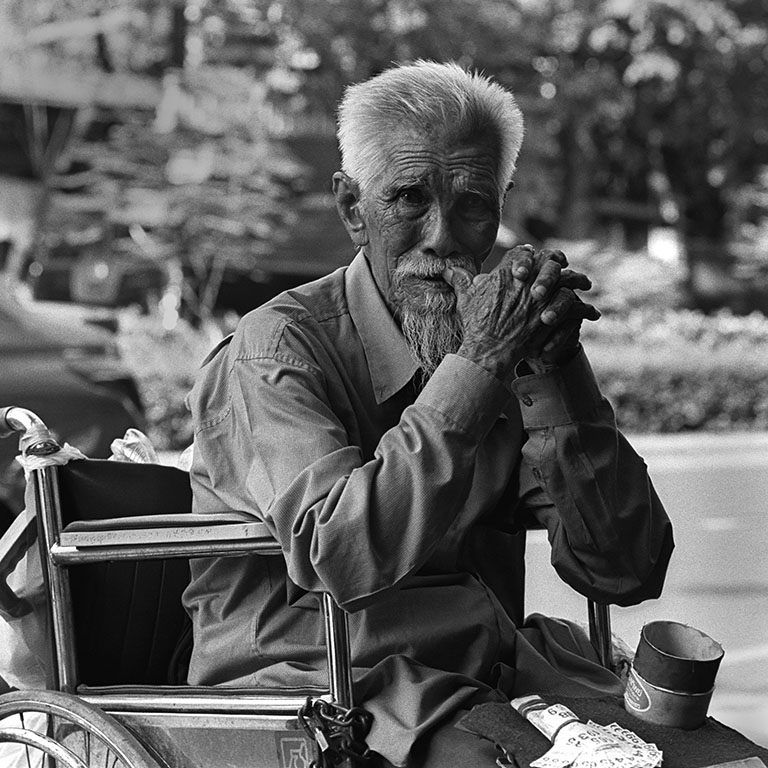
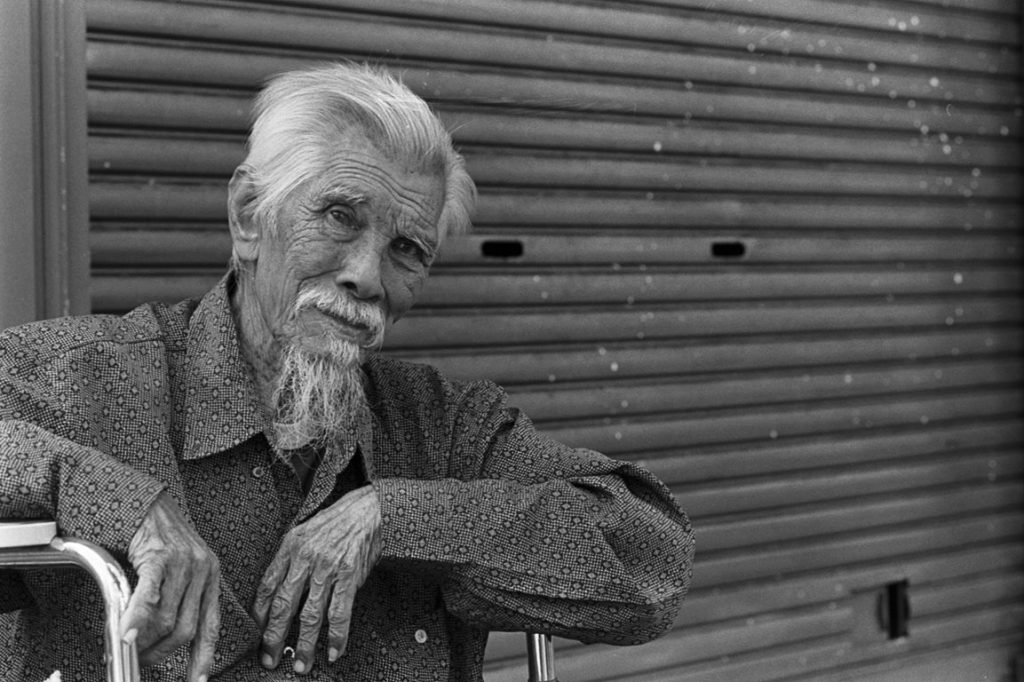
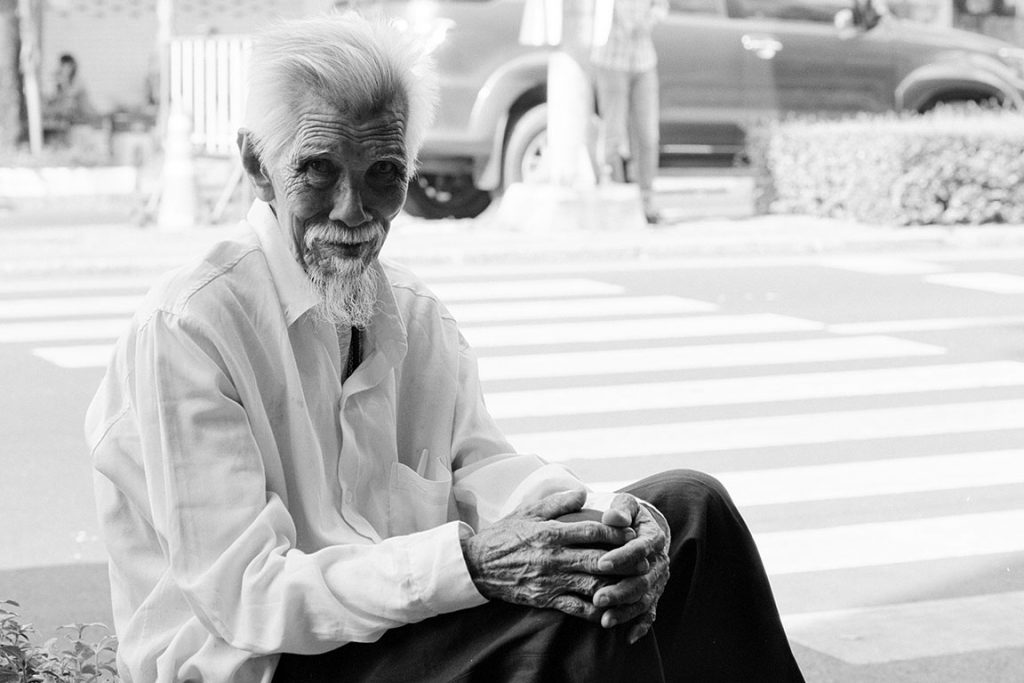
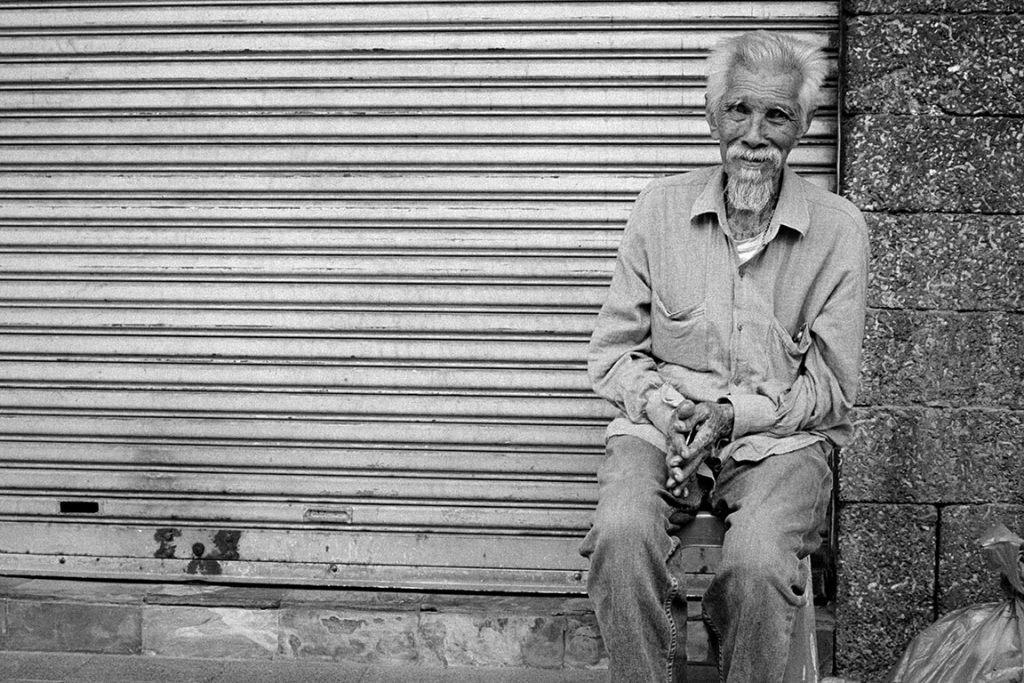
I’m tempted to give my interpretation of these images, though with some hesitation because I believe that interpretation is the prerogative of the viewer rather than the photographer. I was moved by Pappi’s face, his hands and his demeanor. His face with its lines and wrinkles, its prominent eyebrows and cheekbones, was a testament to his long life and accumulated experience. Pappi’s hands attested to a long life of working with his hands though probably not as a manual laborer but rather as a skilled craftsman.
A person’s demeanor is difficult to capture on film. Maybe these images come close. He seemed always to be alert, calm, and reserved, with just the barest hint of a smile. Though we couldn’t communicate directly due the language barrier, the look in his eyes spoke volumes.
The last time I saw Pappi was in 2015. The atmosphere of the image from our final meeting is ethereal, though his eyes, his smile and his hands were as expressive as always. Since 2015, though I’ve been back to Bangkok frequently, I haven’t found Pappi again.
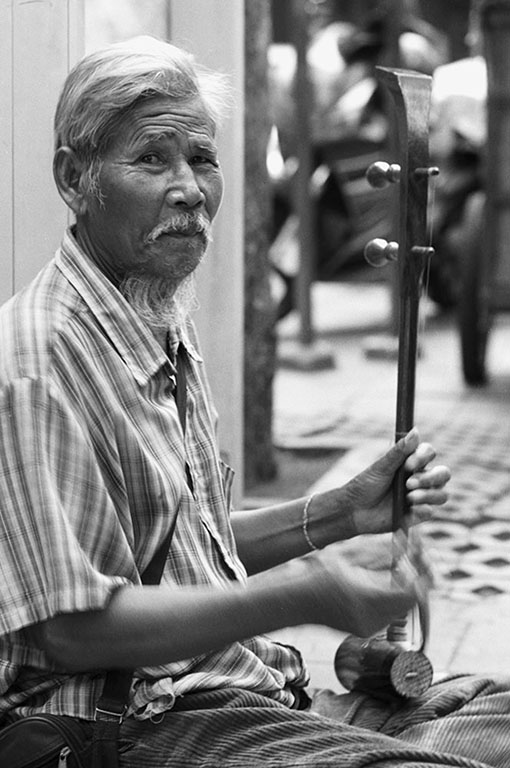
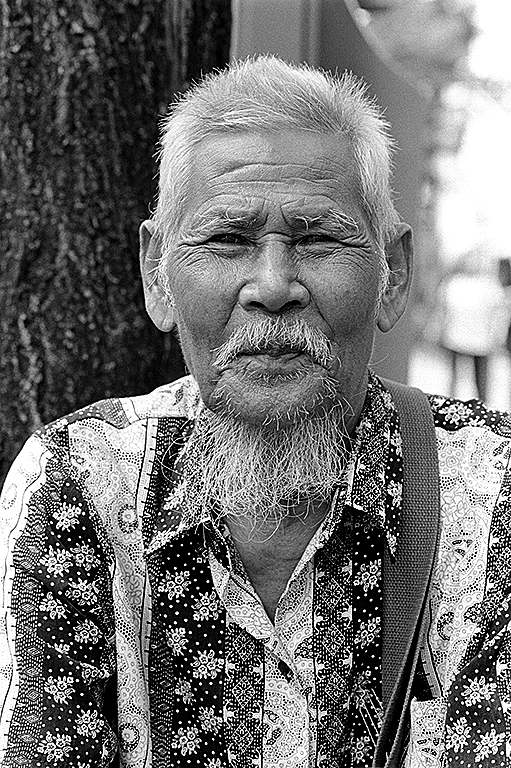
When I first met this man on Silom Road, he was playing Thai folk music on a traditional two-stringed Asian version of a fiddle. His music was high pitched, repetitive and mournful. I encountered him again many years later at the other end of Silom Road. At first I did not recognize him. Only much later when I placed the two images side-by-side did I realize it was the same man. I wonder what it was that drew my eyes to him when I saw him again 12 years later. I can only attribute this to my little inner voice, though certainly the spirit that animated his face was evident as well.
She would walk up and down Silom Road in late afternoon, selling flowers and garlands to be used as offerings at Buddhist temples. She was clearly a street person – scruffy clothes, unkempt hair, barefoot – when I first encountered her. Then she seemed to disappear for a couple of years. When she reappeared the alteration in her appearance was remarkable – her face had filled out, her clothes were clean, her hair was well groomed – but she still walked the sidewalk selling flowers. The serendipitous light on her face turned what might have been a mundane street scene into a remarkably expressive portrait.

Now, the odds against meeting the same stranger repeatedly on Silom Road must be vanishingly slim, especially considering I only went to Bangkok once or twice a year for a week or 10 days at a time. Yet it happened. I’m tempted to speculate that these are more than just random occurrences, but then I don’t have an alternative explanation either. What happens is what happens.
While I consider the photographs of Pappi and the two others to be street portraits, the next series of images instead are more simply photographs of people I met on Silom Road.
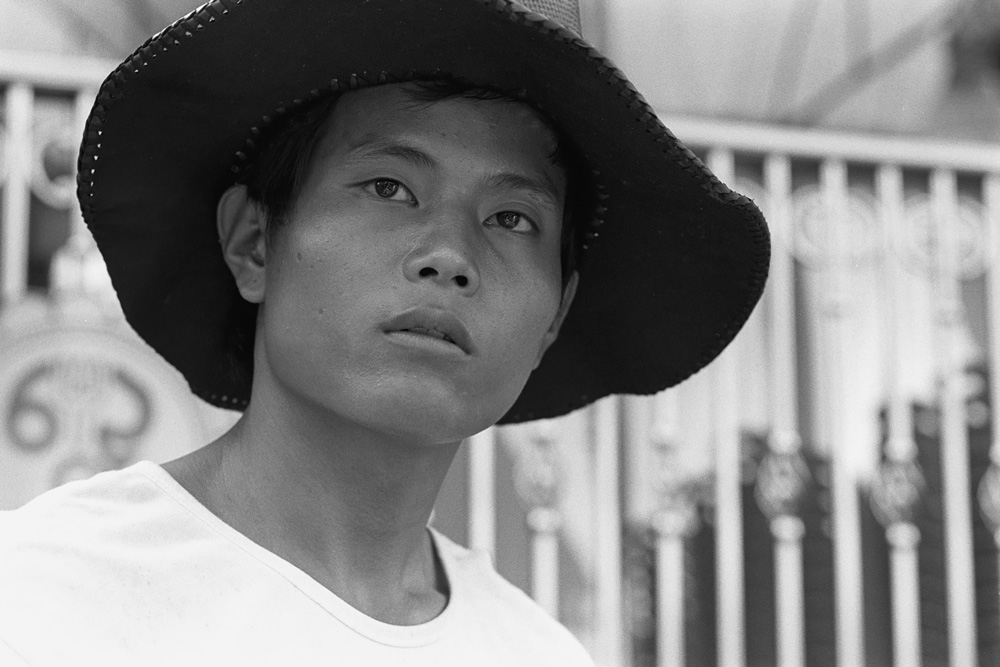
When I asked permission to photograph him, this man readily agreed and then assumed this pose with such a faraway look in his eyes.

An enigma. He was asleep on the sidewalk of Silom Road, with his suitcase as a pillow, but still the look on his face says contentment. Unlike a stereotypical street person, his brow was smooth, his face unwrinkled and his hands clean. Some secret, or some mystery, hides inside this image.
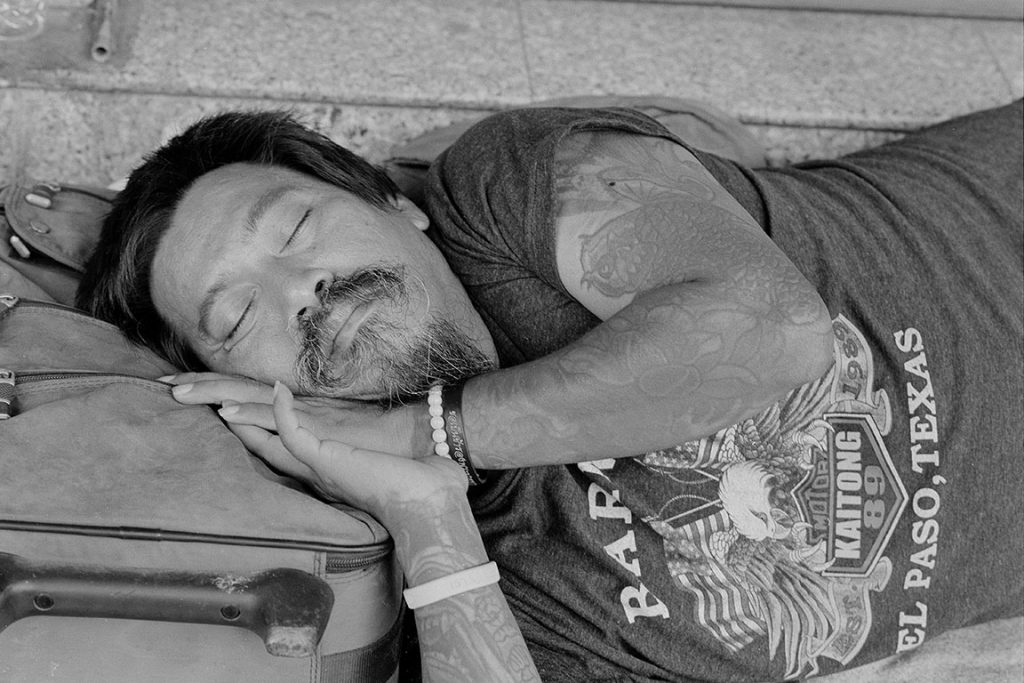
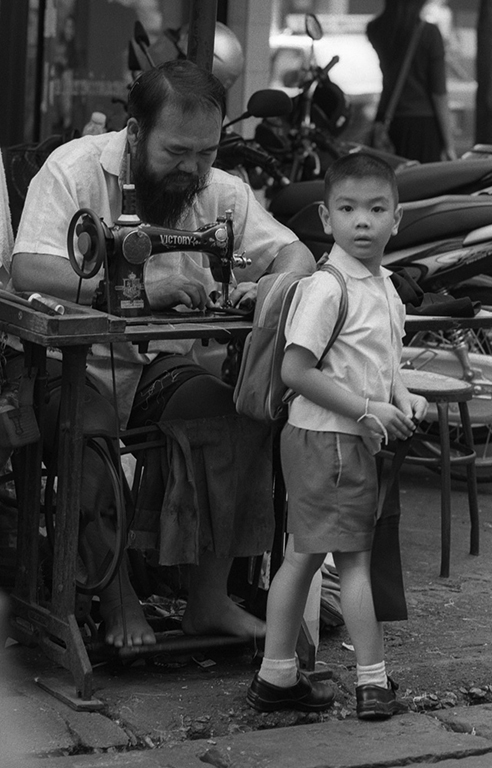

The Thai national lottery is pervasive on Silom Road and throughout the city. Licensed vendors such as this man would offer lottery tickets for sale from a box carried by a strap around their neck. They would walk along the sidewalks and stop occasionally to display the tickets to potential buyers. Other vendors would set up stalls on the sidewalk. Some Thai people take the lottery very seriously, poring over the tickets before deciding which number to buy. From my point of view, these vendors are just another side of street life.
The strength of this image lies in the man’s face. He contradicts the stereotype of a street vendor. He is basically a man trying to make a living.
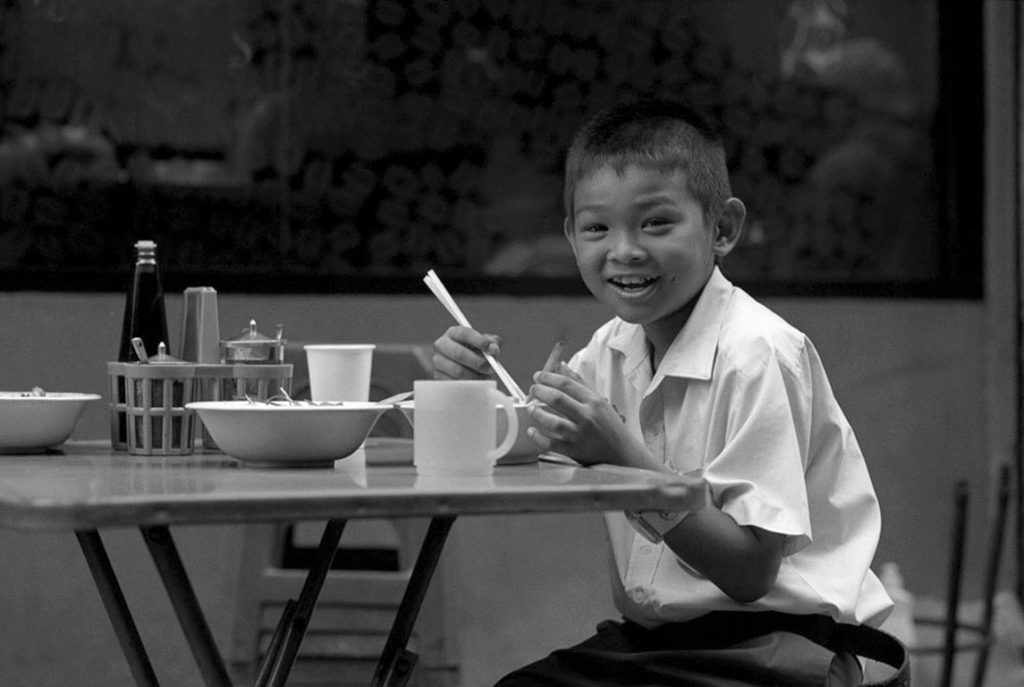
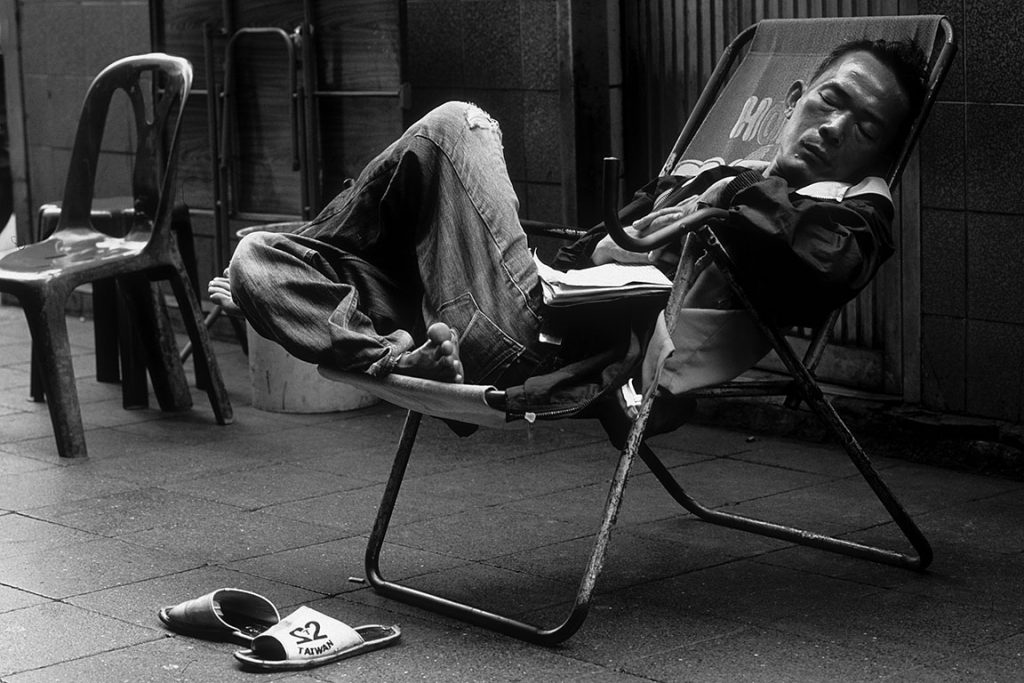
From my point of view, I can divide my photographs of Silom Road into two broadstroke categories: people and activities. In real life these two generally are inseparable. The distinction arises from the intention behind a photograph. When the focus is on the person, the image becomes a portrait. Alternatively, street photography focuses on activity. The images thus far in this episode have been portraits (or I prefer to call them street portraits). Let me now change the focus to street photography for the rest of the episode.
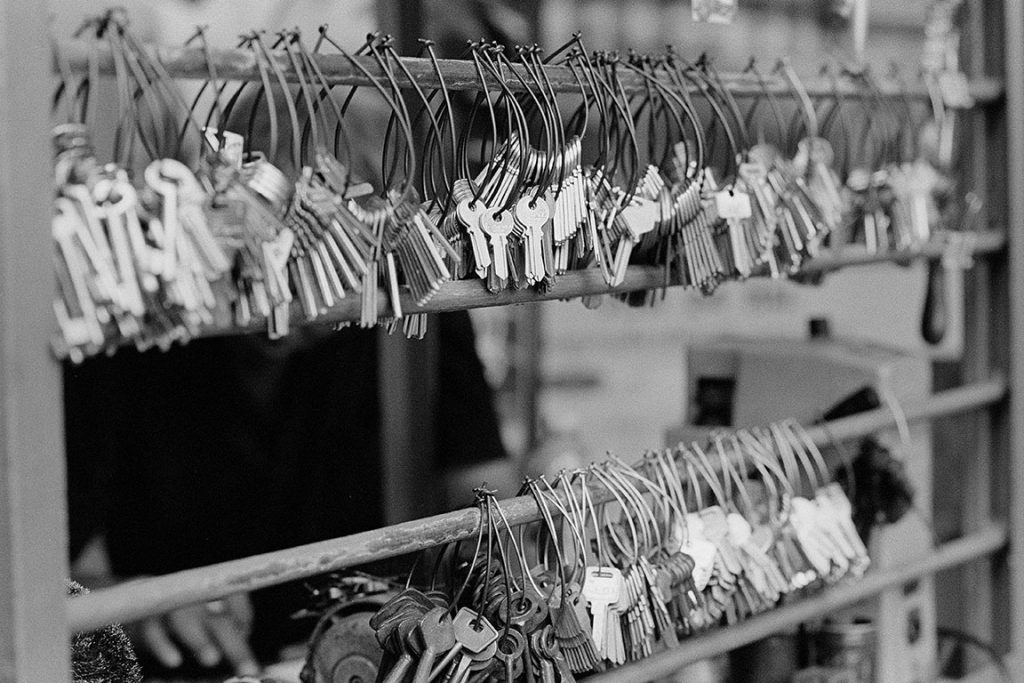
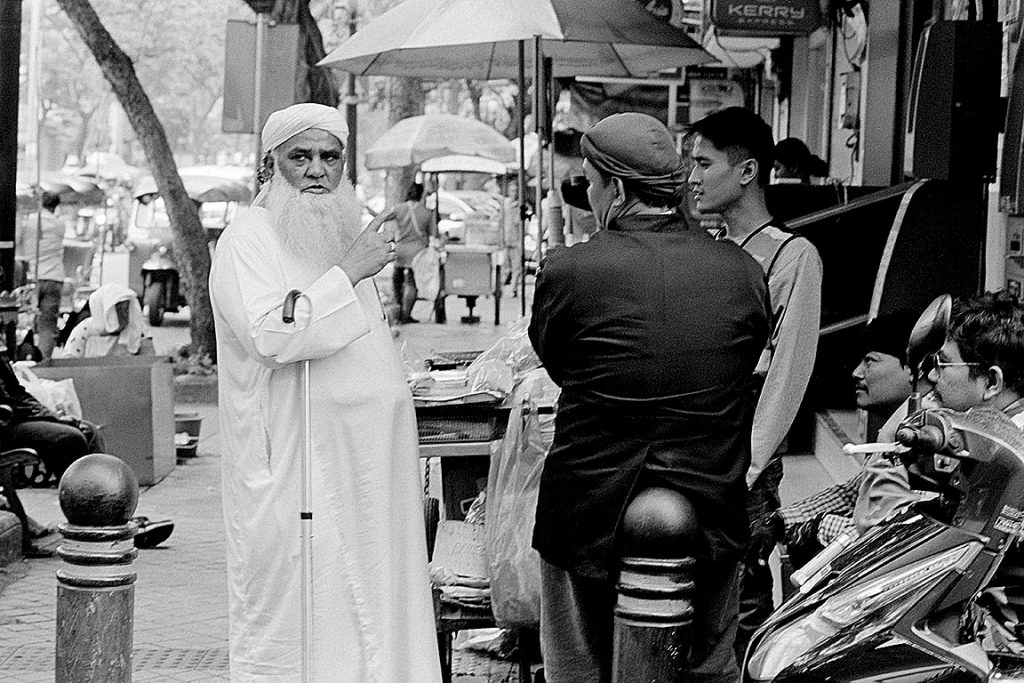
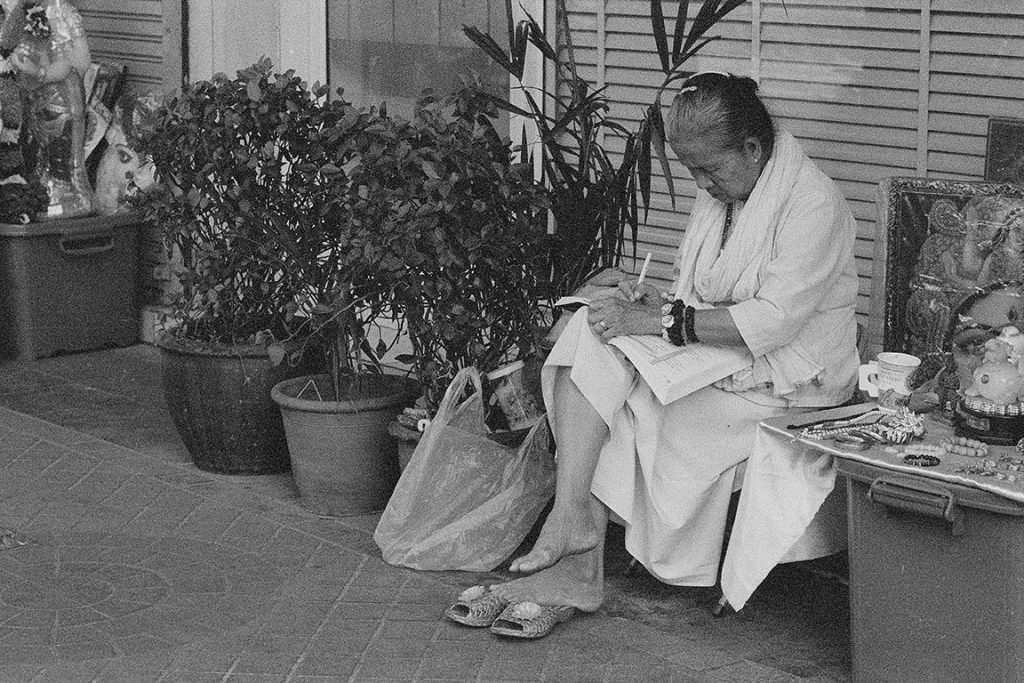
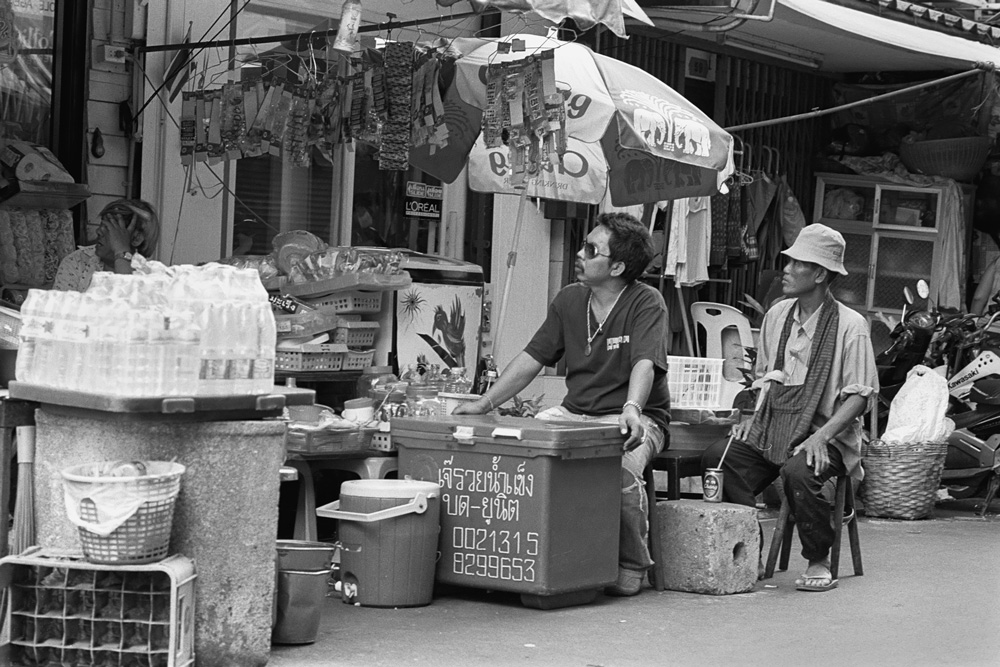
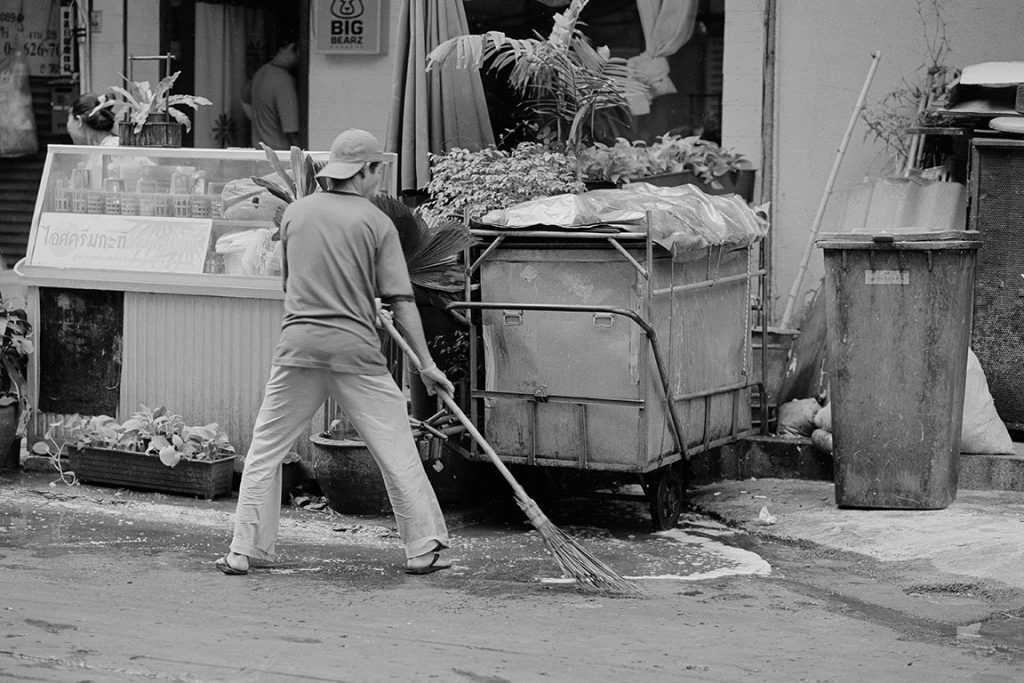

Let me take a slight detour from Silom Road onto a side street known as Soi Pan (in Thai language, “soi” means a short side street off a main road.). While it is hardly unique as a side street, Soi Pan illustrates many facets of life on Silom Road. These images are from a mere 2-block stretch of the street, just off Silom Road.
The first block of Soi Pan was lined on both sides almost exclusively with food vendors of various sorts. Some were traditional pushcart vendors. Some were storefront diners with tables spilling out onto the sidewalk. One was a Chinese kitchen specializing in stewed pork to go. One was Soi Pradit Market, an unexpected combination of a fresh fruit and vegetable market and a sidewalk diner.
The arrangement of the cooking spaces, and the actual cooking of the food, seemed to be rather loosely organized. On one side of the street (actually on the street itself) three or four cooking spots occupied adjoining spaces, with open flame charcoal grills, cookers fired with bottled gas, and so on. In this rather complex image, a man was preparing food in the foreground, while a table and chairs for customers stood in the midground, and the entry to the fresh fruit, vegetables and meat market was in the background.
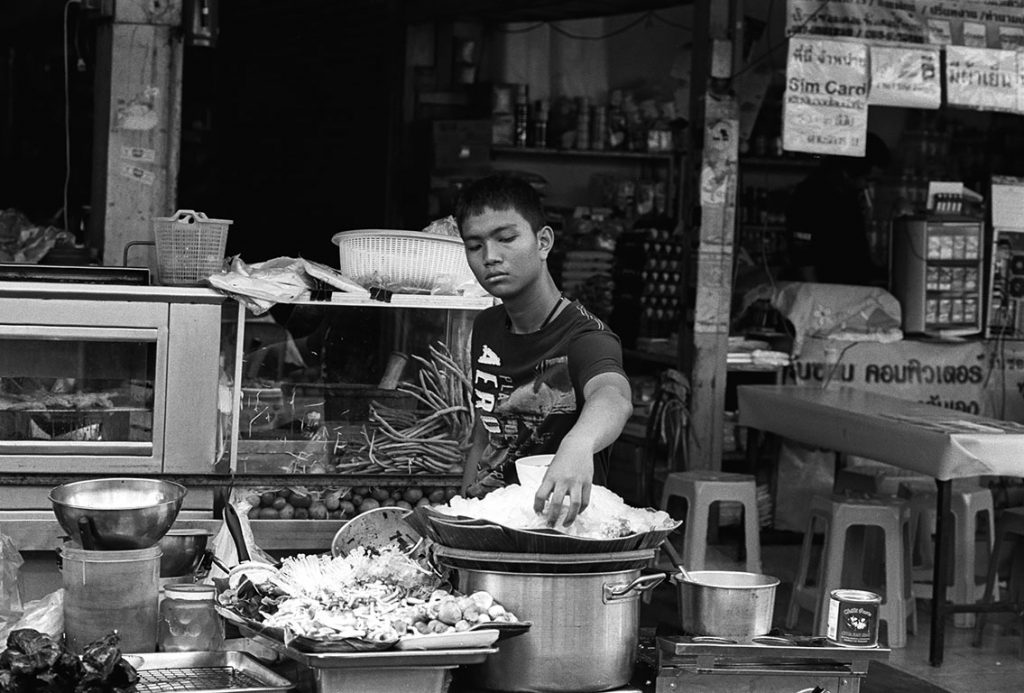


At midday, businessmen from the neighborhood would come to Soi Pan for an al fresco lunch. The setting would be decidedly low key, which probably drew them to this spot.
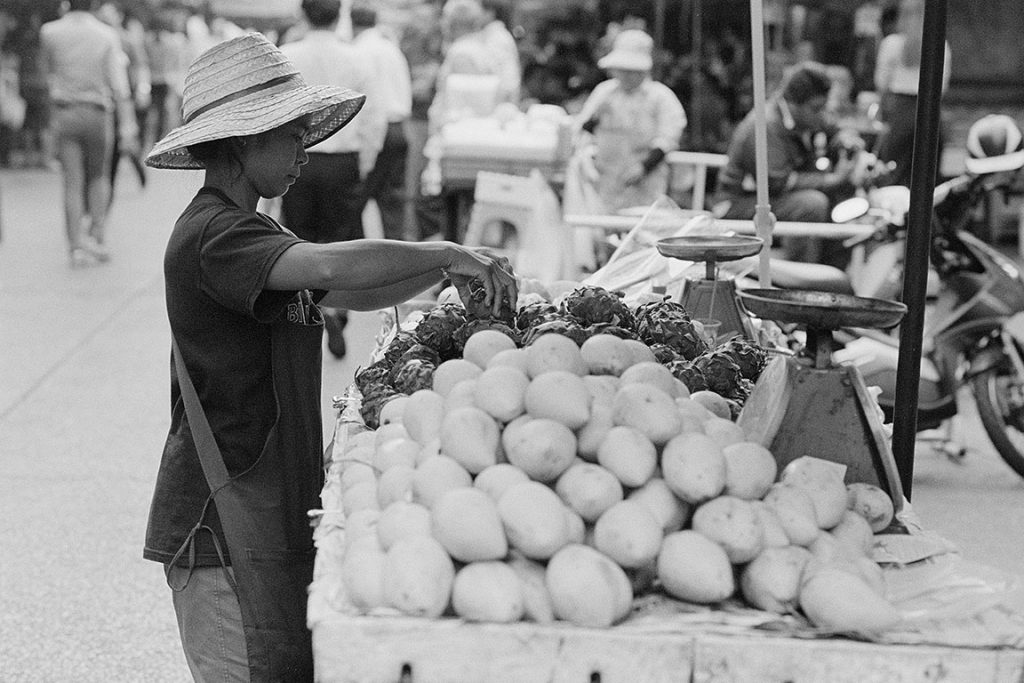
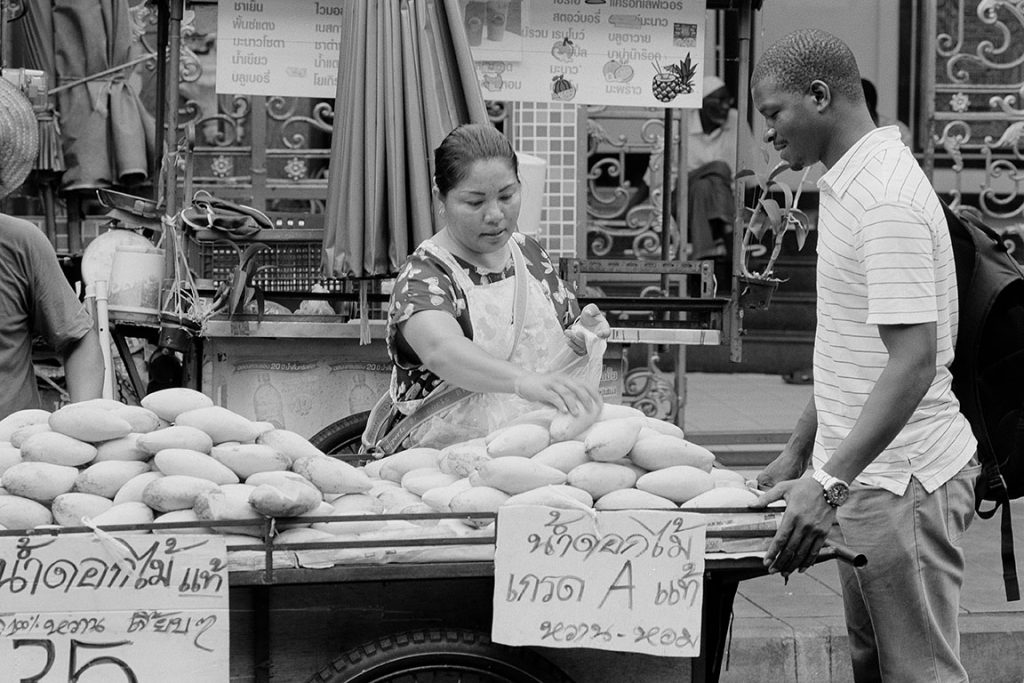
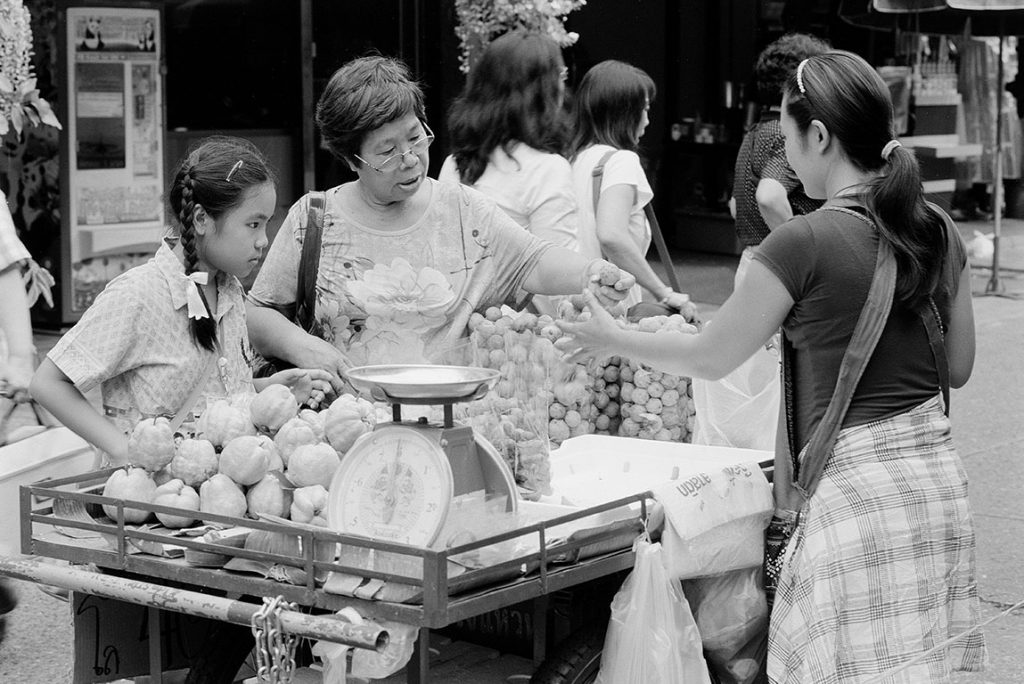
Pushcart vendors also would operate on Soi Pan. These vendors seemed to be more mobile on Soi Pan, stopping for a while to sell some of their goods to customers, then moving on – to be replaced by other pushcarts.
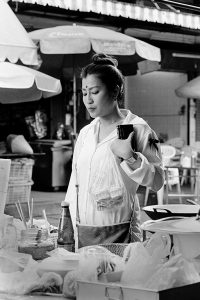
Patrons at Soi Pradit Market would be an eclectic mix. In this photograph, the woman’s quiet elegance contrasts with the casual atmosphere of the street food vendors and creates the dynamic of the image. She was wearing a black ribbon pinned to her sleave, a symbol of mourning for the late king Bhumibol, who died in October, 2016, and this adds a touch of poignance to the photograph.

Food at this diner would be cooked on open charcoal grills on the sidewalk while patrons sat at oil-cloth-covered tables under canvas awnings.
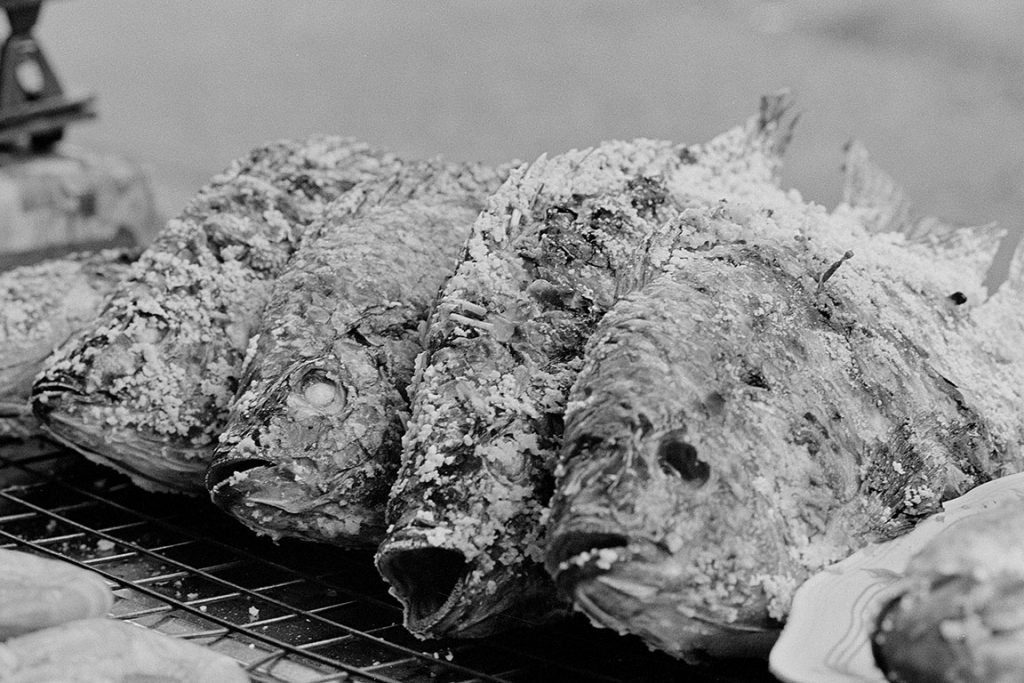
The people of Silom Road run the gamut of socio-economic classes – from business people and shoppers, to blue collar workers, to street vendors, and yes to…what shall I say?…street people.
I am drawn to street people as subjects.
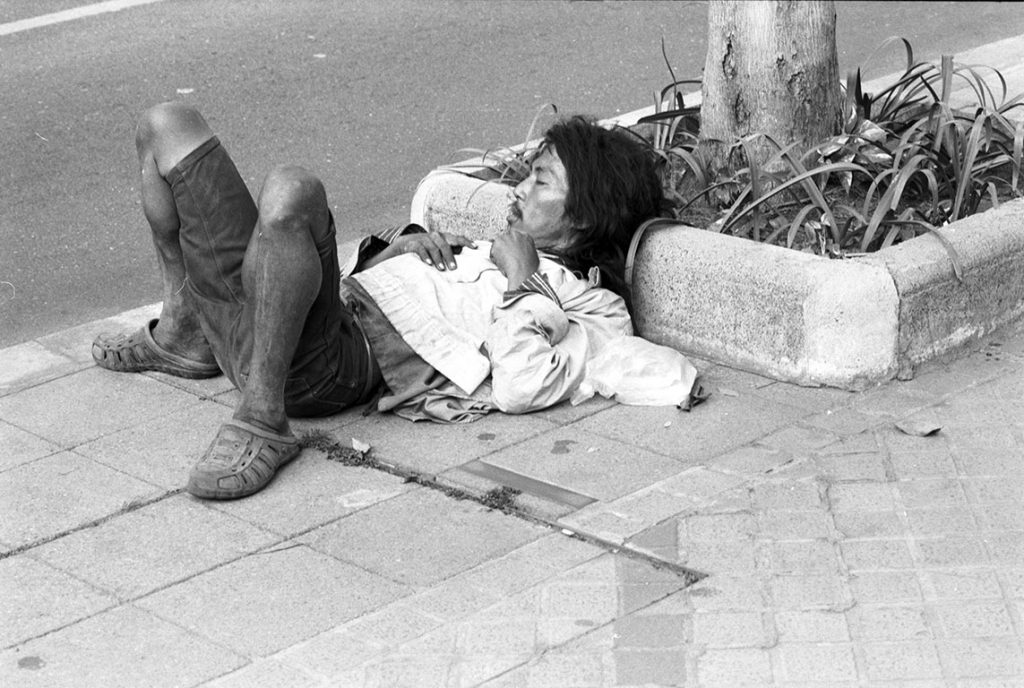
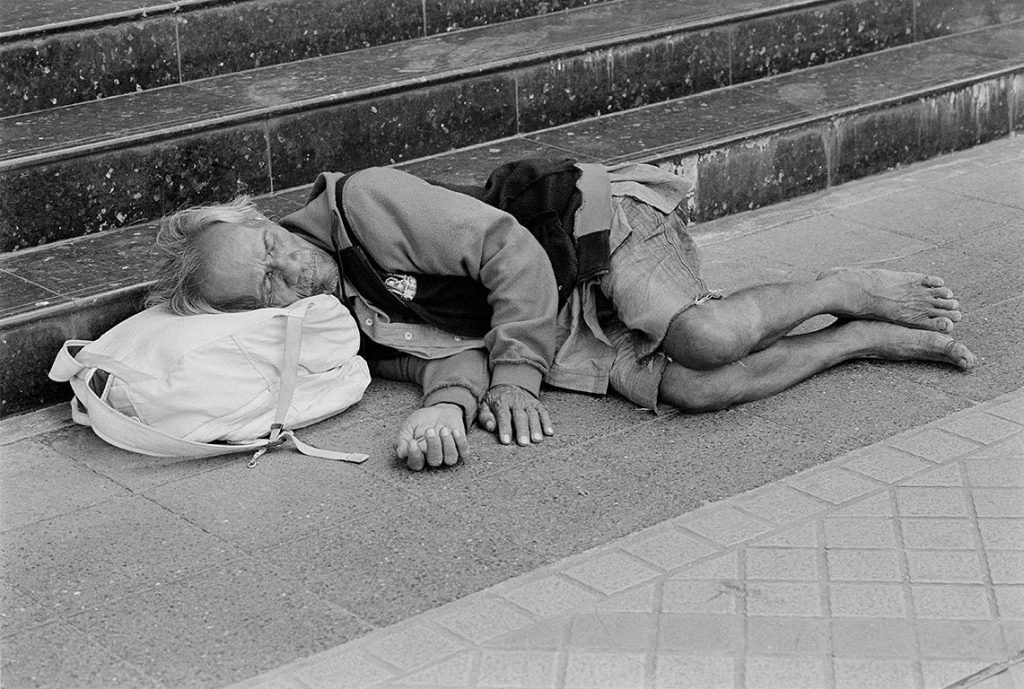
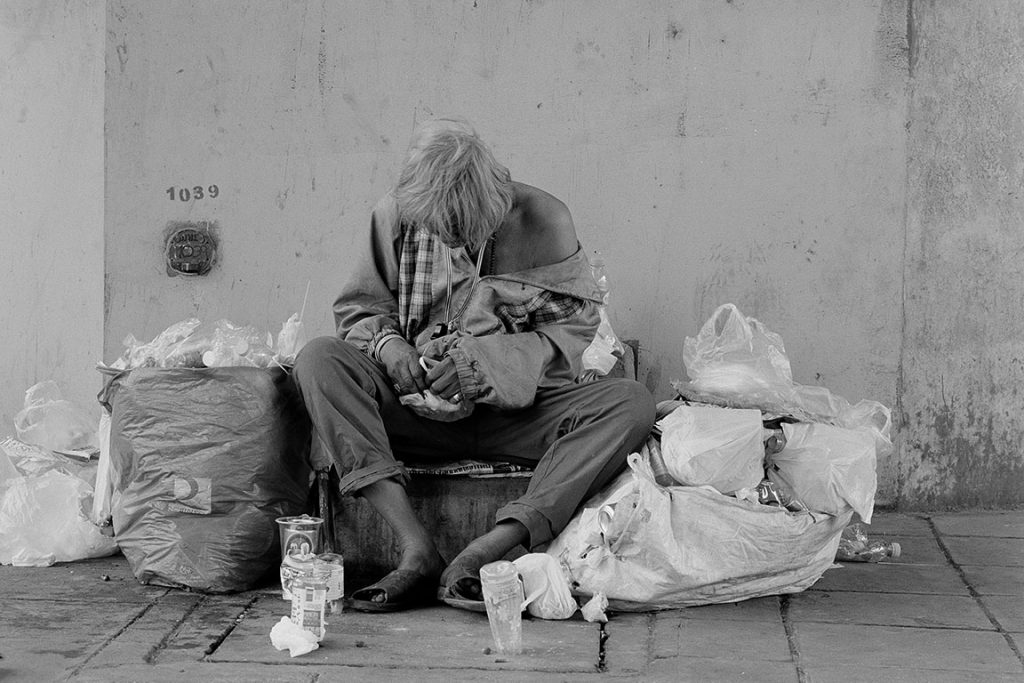
Documentaries about the homeless have been created by other photographers. I include this image here to further illustrate the variety of life on Silom Road, rather than to make a statement about homelessness. Homeless people are relatively few there but they are part of the reality of Silom Road. When I consider this photograph, the main impression I get is of the man’s loss of hope. This is evident in his body language, I think. This is a painful image to view.
At the foot of Silom Road, near the elevated highway, the character of the street changed markedly. Many of the buildings were vacant or in the process of being demolished. Few, if any, pedestrians walked the sidewalks there. Overall the mood was of desolation. This area seemed a curiosity to me. Possibly the area would undergo urban renewal, though I never saw signs of active demolition or new construction.
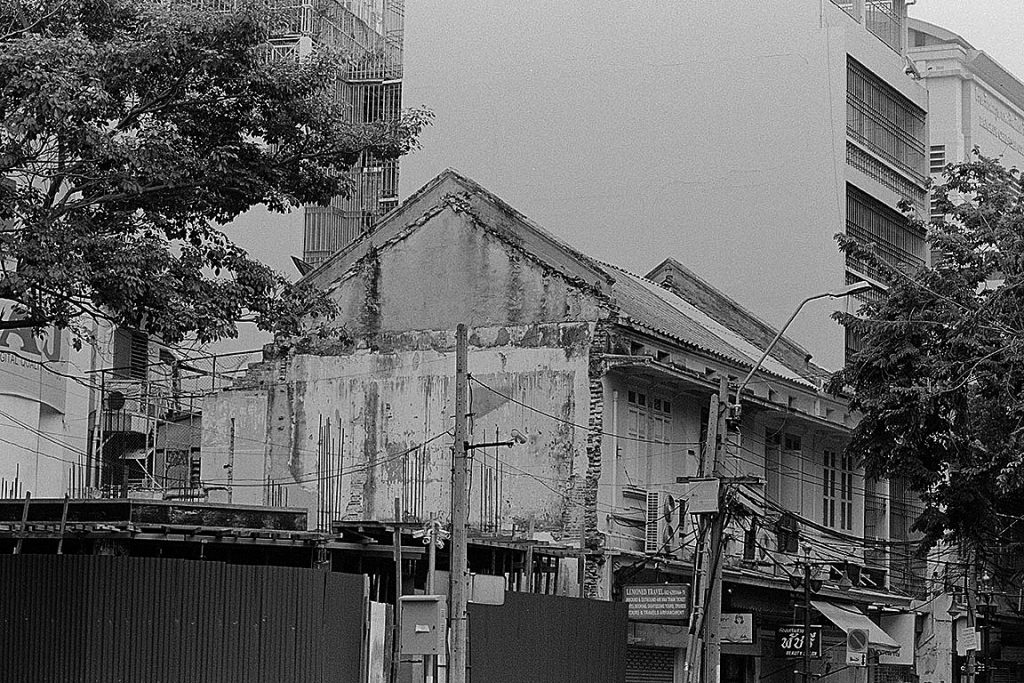
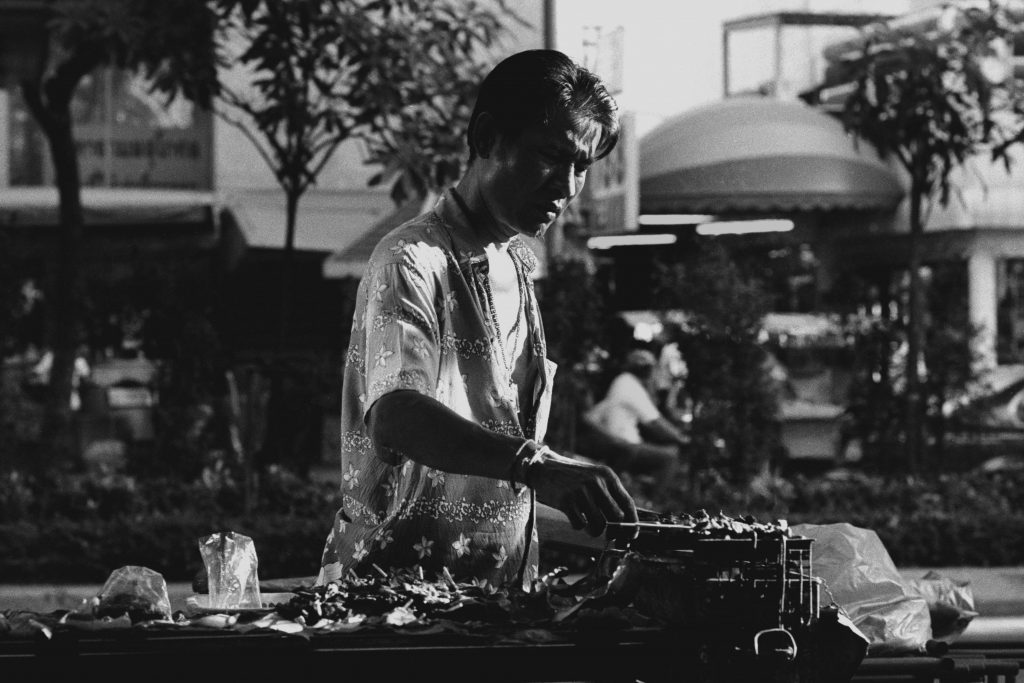
Late in the afternoon toward the end of the year, the setting sun would shine directly down Silom Road, bathing the scene with that special late-afternoon light. Under conditions like this I didn’t need my little inner voice to guide me and my camera. The sidewalks – no, make that the people on the sidewalks – would come alive.
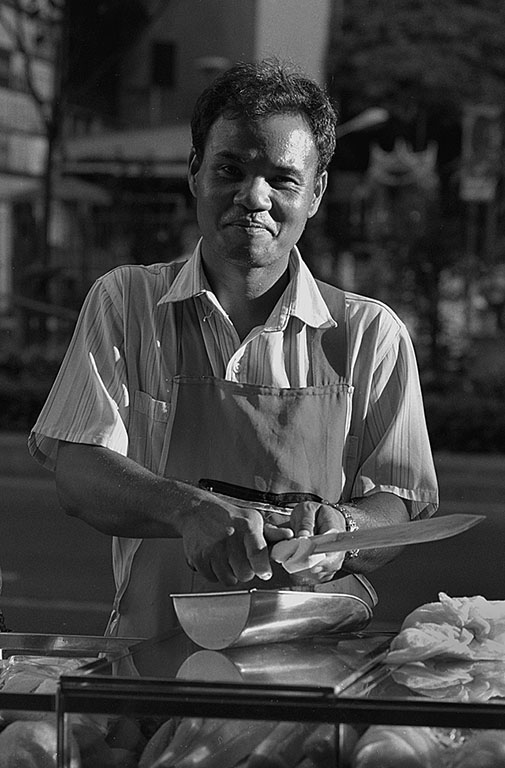
The pride in his work shows in this image. His smile was just for my camera, but his body language tells the story.
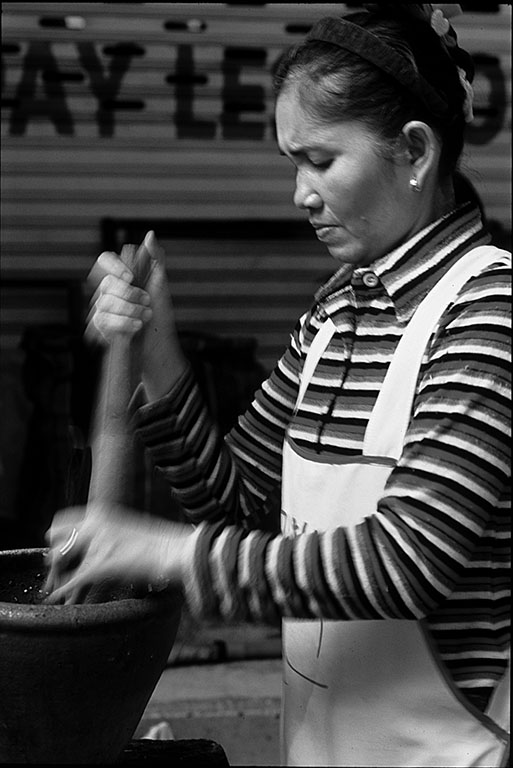
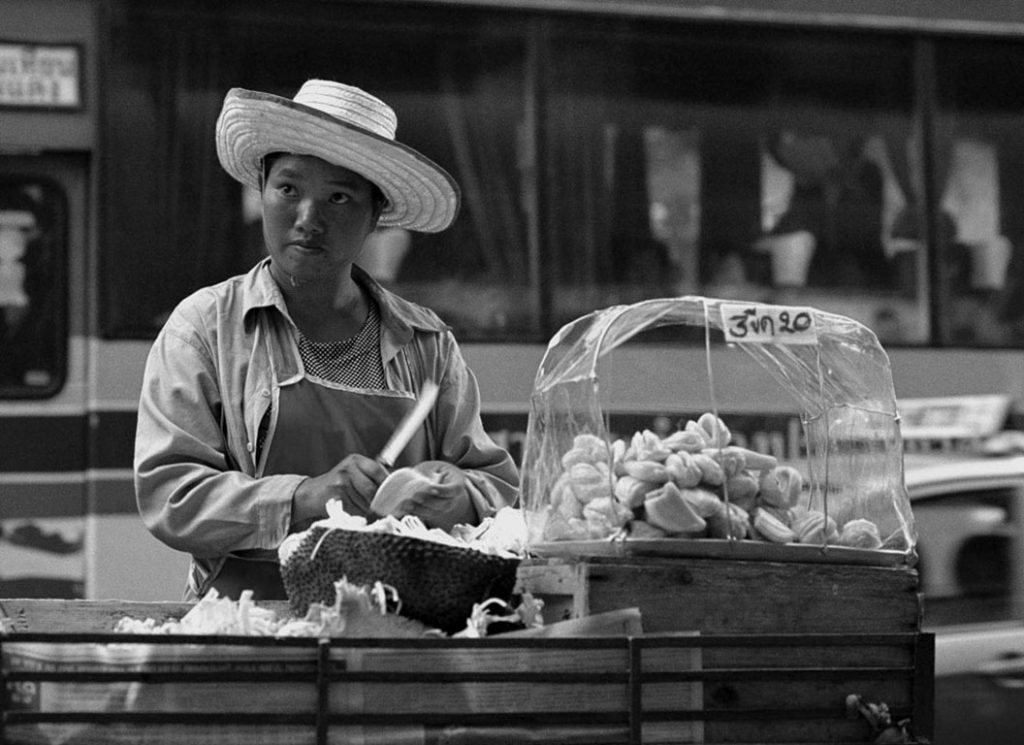
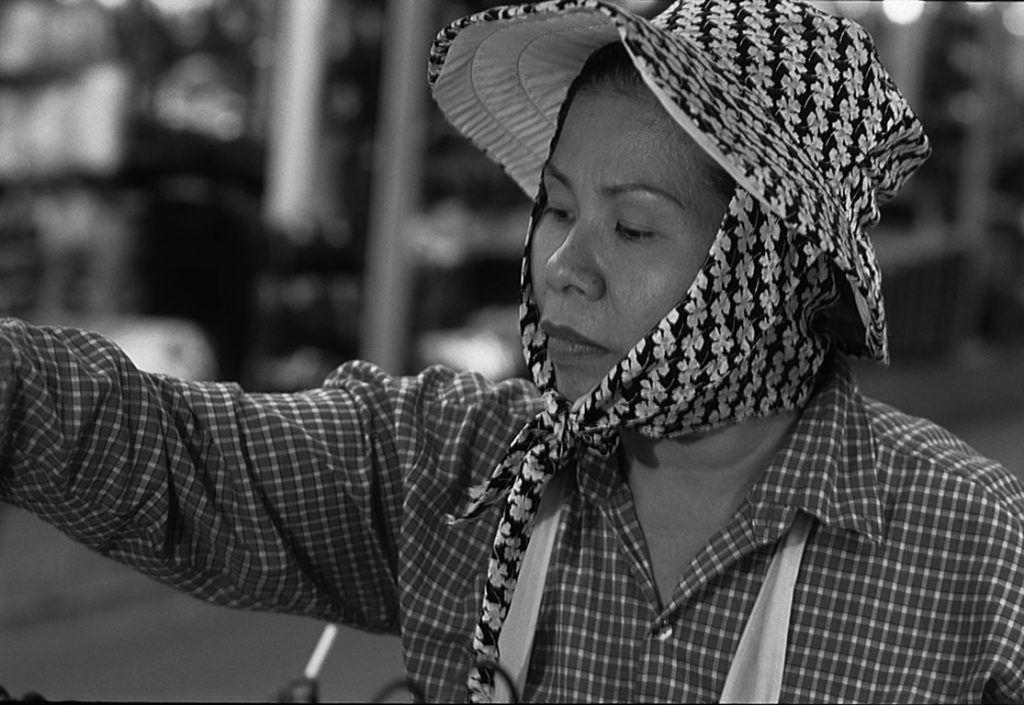
This woman made and sold deep-fried chicken. I found her year after year on the same street corner.
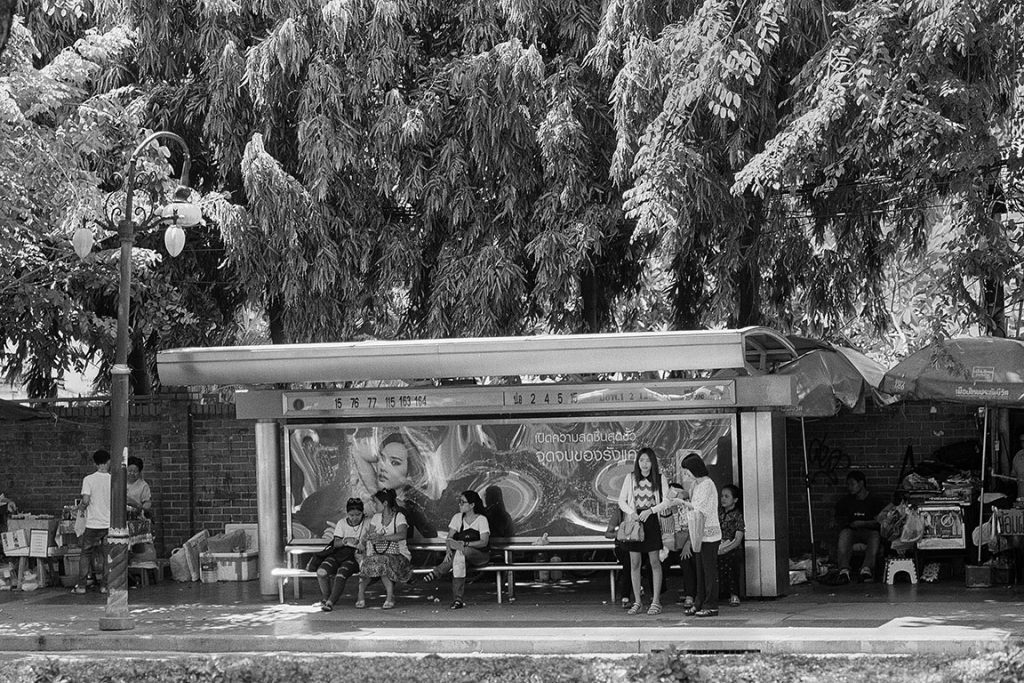
This episode of The Monochrome Chronicles has focused on my series of photographs taken along Bangkok’s Silom Road, a divided street with a green median and tall trees on either side providing welcome shade on the sidewalks. Walking the entire length of the street, which would take me about 30-45 minutes each way at a leisurely pace, I found the variety of street life there…well, the variety was so wide that words fail me. While other areas of Bangkok may offer more conventionally picturesque views, Silom Road is the place for me and my camera.
From my personal point of view, the character of life on the streets shifts as Silom Road traverses its way from its start near Lumphini Park, along its almost perfectly straight short distance, to just past the elevated highway. I see a progression through three segments: crowded and hectic in the first segment; calmer and more laid back in the middle segment; and almost abandoned in the final segment.
Silom Road itself is crowded with traffic but in contrast the soi (side streets) are narrow with little traffic. There the buildings are old and neglected. Some blocks give the feeling that time has stood still since somewhere back in the 1950s, especially late in the afternoon when the heat of the day becomes oppressive, people slow down, and even the dogs find it’s too hot to do anything but sleep.
I can scarcely express my experiences on Silom Road in words. Maybe my photographs will do that for me. Just remember, though, that most of these images came from just a small glimpse of the day, only 2 hours in late afternoon. Accumulated over the course of about 15 years, of course.
Segue
By dividing the photographs from Silom Road and Charoen Krung Road into two separate episodes of The Monochrome Chronicles, the implication would be that their character likewise differs. Such is the case. There are, of course, similarities as well. From my photographers’ point of view I’ve found four images – two from each street – that are remarkably similar. One word of caution, though: the similarity is in the aesthetics of the photographs. There is no hidden meaning here, no implication about street life in the two neighborhoods. In this instance, a cigar is just a cigar.
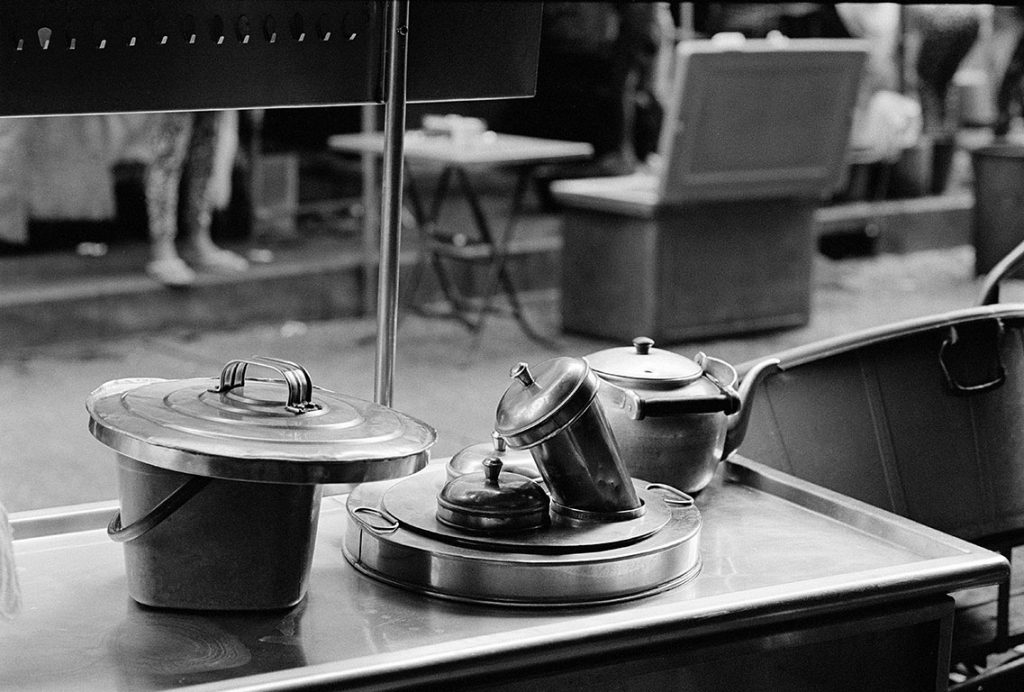

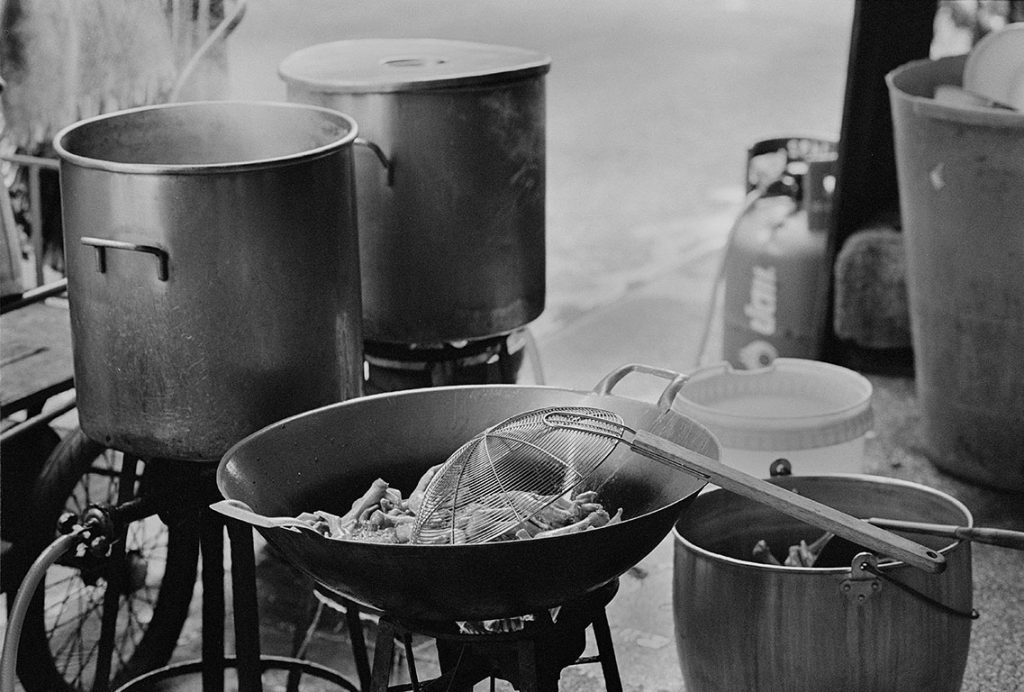
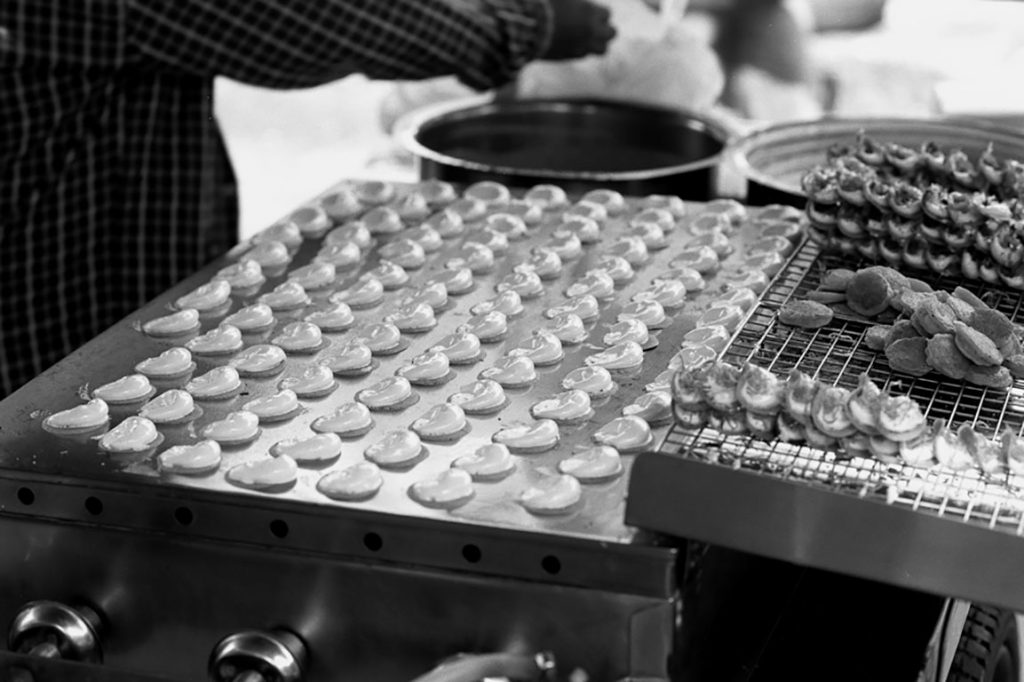
A portrait of street food in Bangkok. On a photorealism level, these images show details of pushcarts on the sidewalk. They are a bit more upscale than most pushcarts, made with stainless steel and supplied with bottled gas for heat.
Such equipment would be unremarkable in the back room of a bakery or a restaurant, but in the context of pushcarts on the sidewalk they represent an element of street life in Bangkok.